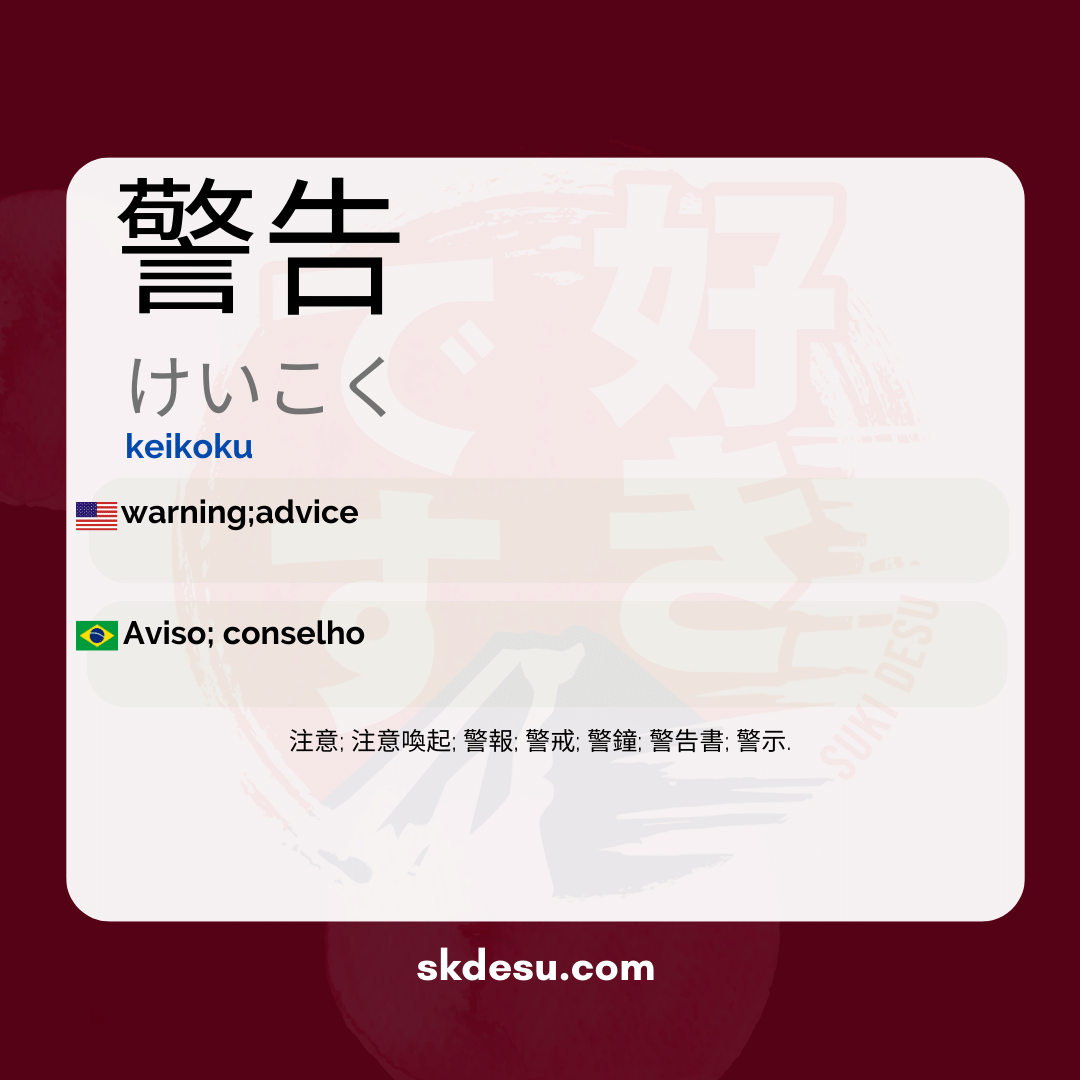Translation and Meaning of: 警告 - keikoku
If you have come across the Japanese word 警告[けいこく] and are curious about its meaning or usage, this article is for you. Here, we will explore everything from the basic translation to the cultural context in which this expression is used. Additionally, we will see how it appears in everyday Japanese and tips for memorizing it effectively. Whether for studies or simple curiosity, understanding 警告 will enrich your knowledge of the Japanese language.
The meaning and translation of 警告 is "warning".
The word 警告[けいこく] is composed of two kanji: 警 (vigilance, alert) and 告 (announcement, notice). Together, they form the term that means "warning," "alert," or "notice." It is used in situations where there is a need to draw attention to a danger or inappropriate behavior. For example, traffic signs or messages from electronic systems often use this word to indicate risks.
In English, the most common translation is "warning," but depending on the context, it can also be interpreted as "caution" or "advisory." The nuance is important: while "caution" suggests precaution, 警告 carries a more urgent tone, almost like an order for the person to stop or reconsider their actions.
Everyday and Cultural Use of 警告
In Japan, 警告 is a common word in formal and institutional settings. Companies use it in codes of conduct, schools in regulations, and even in government notifications. A classic example is weather alerts, where 警告 indicates severe weather conditions, such as typhoons or earthquakes. In these cases, the word is not just informative but an instruction to take immediate action.
Culturally, Japanese people tend to avoid direct confrontations, so 警告 often appears in writing instead of being stated verbally. This reflects the preference for communicating issues indirectly, preserving social harmony. In animes and dramas, you may notice its use in scenes where authorities or figures of power give solemn warnings.
Tips to memorize 警告
An effective way to fixate 警告 is to associate its kanjis with real situations. The first character, 警, appears in words like 警察[けいさつ] (police), linked to the idea of surveillance. On the other hand, 告 is found in 告白[こくはく] (confession), related to communicating something. Thinking about these radicals helps understand why 警告 means a formal notice or alert.
Another tip is to practice with concrete examples. Write down sentences like 警告を無視しないで (Don't ignore the warning) or システムが警告を表示した (The system displayed a warning). Repeating these constructions in different contexts reinforces learning. Tools like Suki Nihongo provide interactive exercises that can assist in this process.
Vocabulary
Expand your vocabulary with related words:
Synonyms and similar words
- 注意 (Chūi) - Attention
- 注意喚起 (Chūi kanki) - Attention alert (drawing attention to something important)
- 警報 (Keihō) - Alert sirens (emergency warning)
- 警戒 (Keikai) - Surveillance (caution against a potential threat)
- 警鐘 (Keishō) - Alarm signal (calling attention to imminent danger)
- 警告書 (Keikōsho) - Alert notification (formal notice document)
- 警示 (Keiji) - Warning or danger signal (visual warning)
Romaji: keikoku
Kana: けいこく
Type: noun
L: jlpt-n3
Translation / Meaning: Notice; advice
Meaning in English: warning;advice
Definition: To report a problem or danger.
Quick Access
- Vocabulary
- Writing
- Sentences
How to Write in Japanese - (警告) keikoku
See below a step-by-step guide on how to write the word by hand in Japanese. (警告) keikoku:
Example Sentences - (警告) keikoku
See below some example sentences:
Nenhum resultado encontrado.
Other Words of this Type: noun
See other words from our dictionary that are also: noun

